Pikmin 4 was officially announced late last year and released on July 21st which was almost a decade to the day after the release of Pikmin 3 in 2013. In between these two releases there was the mediocre spinoff for 3DS, Hey! Pikmin released in 2017, Pikmin 3: Deluxe a port for Switch in 2020 and the mobile exclusive Pikmin Bloom released in 2021. These releases aside, this was the largest gap in mainline releases since that between 2004’s Pikmin 2 and Pikmin 3 which came close to a decade. And within this period, the first two games were given enhanced releases on the Wii with the “New Play Control!” branding incorporating the Wii controls so well that they were retained as an option in Pikmin 3.
As sparse as this release history may be, it is not at all surprising considering that the series has never been a big seller for Nintendo though it has always been modestly successful. All the mainline games were well-received critically and are fondly remembered by most people who played them — myself definitely included. I was actually one of the very first out the gate my my review of Pikmin 3 back in 2013, as it was released in Japan a few weeks earlier and saw the site I originally wrote for get a brief but noticeable jump in traffic. The game did little if anything to improve sales for the already struggling Wii U but then no subsequent game releases really did. Given the comparatively low sales with other Nintendo franchises, Pikmin 4 was never a sure thing but on release had the most successful launch in the series history as well as being critically well-received. My review is late but I think it contrasts enough with what has already been said to be worth writing. This review will assume some knowledge of the series which is basically a hybrid of real-time tactics and action/adventure genres.
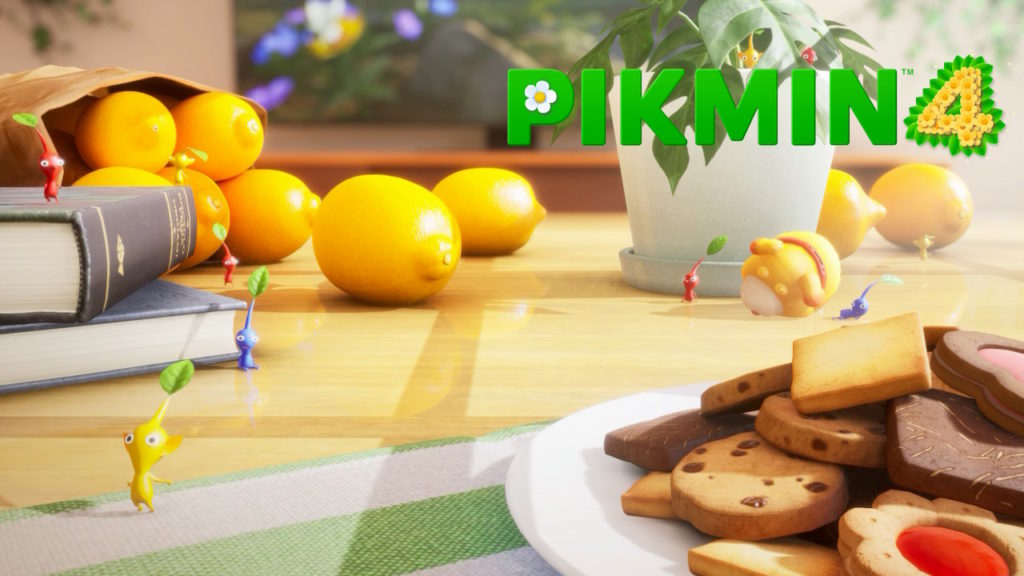
Re-reading the linked review of Pikmin 3 above was somewhat odd because while I don’t consider any of the criticisms I made wrong, I would now consider the third entry to be my favourite in the series. I replayed it again a few years ago and enjoyed it just as much the second time. It has been a long time since I played the two original games but I know I preferred the first overall to the second — though I generally find that the second is often considered the best by most fans of the series. Pikmin 3 was closer to the original with the focus being largely above ground and with the amount of days to complete the overall mission being limited. Pikmin 4 takes more after the second game with time limited only to what can be accomplished in a single day but with no limit on how many days the player spends overall. As well as this, the dungeon crawling makes what is in most ways a welcome return. It also has new and returning Pikmin, new characters and plenty of new features.
While Pikmin 4 is a numbered sequel, it is also a reboot as the events of the previous games have been either retconned or ignored completely. It would require a significant amount of effort to square the circle connecting the games logically and this might be a drawback for those that enjoy the series lore. The game begins with Captain Olimar of the S.S. Dolphin getting stranded on PNF-404 which is exactly what happens in the original game. This time these events happen differently and Olimar shows no knowledge of Pikmin or any of the events of previous games. He befriends a creature who he names Moss which is basically a giant dog Pikmin. The player initially takes control of Olimar and interestingly within indoor environments that are a first for the series. This more or less a short tutorial as soon after you’re asked to design and name your own character (also a first for the series), who is part of the Rescue Corps sent to save Olimar. After this, you take control of your own character and soon meet your own little dog who is named Oatchi. The introductory parts of the game including the first main area are available in the demo; which helpfully also allows progress to be saved and continued in the full version.
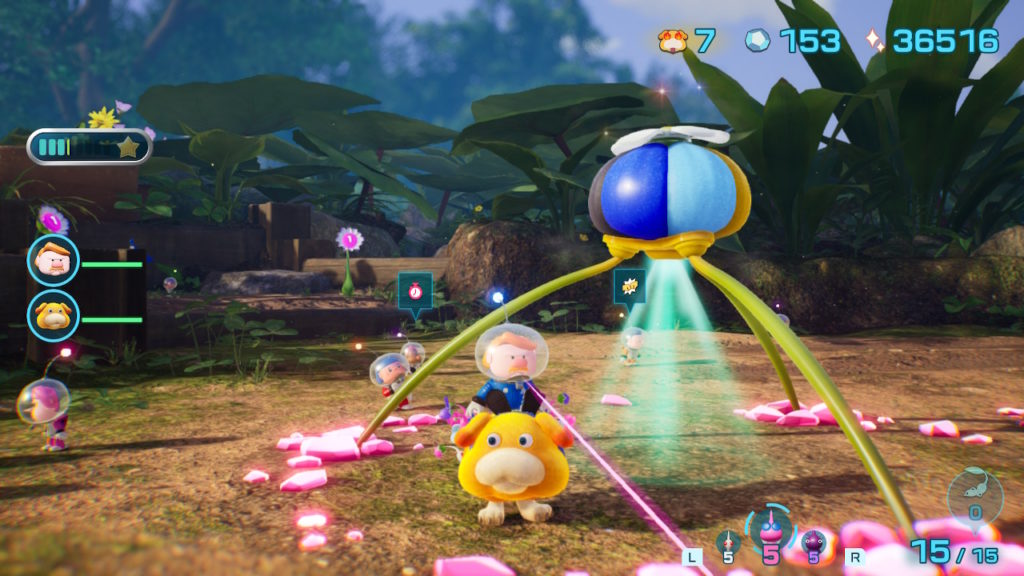
Oatchi in the game’s hub area.
Oatchi is perhaps the most interesting addition as his presence both adds to and changes the gameplay of the series. He can be ridden by your character, controlled separately and ordered around like a Pikmin. He also has the ability to swim, jump and smash through or knock over obstacles. He adds both platforming and vertical gameplay elements to the series which were previously absent. He is also a big part of the new progression system as he can unlock new abilities which can also be upgraded over the course of the game. The player character also has enhancements to unlock but this system is far more robust with Oatchi. I would single out his inclusion as the best part of the game overall. I got so used to riding him through the various areas that I would immediately miss him if I replayed the original games.
His presence also makes the game much more friendly to newcomers as Pikmin are less vulnerable when on his back and he can be used in combat instead of Pikmin. He has a number of other helpful abilities such as being able to sniff out treasure, items or points of interest which reduces the challenge of knowing what to do next. As with the multiple characters introduced from Pikmin 2, he can also be controlled separately and even have Pikmin under his command. There are some special doors only accessible with Oatchi and the player character also can’t do any platforming without him and all areas of the game incorporate platforming elements to some extent.
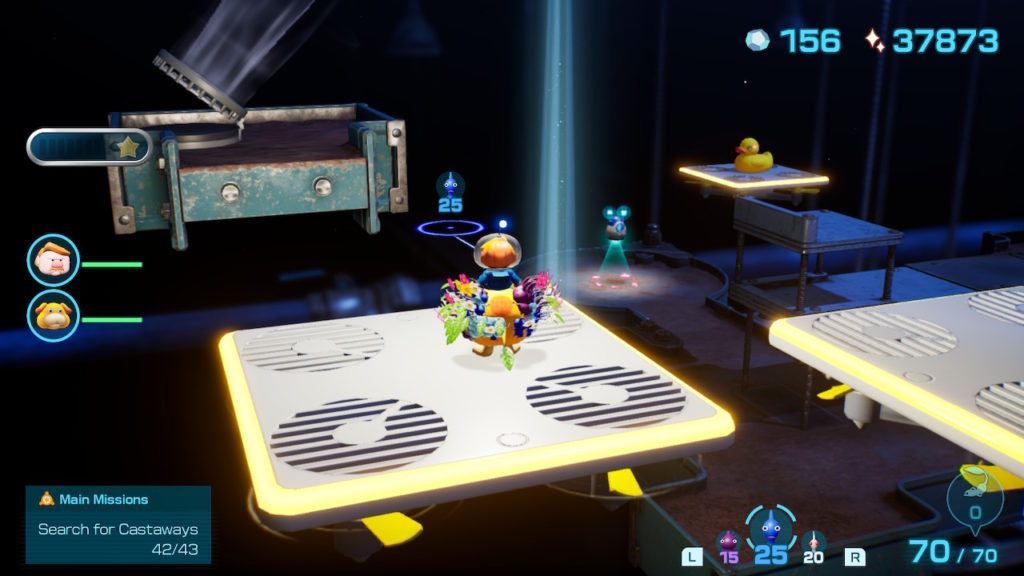
An example of the vertical gameplay using Oatchi.
From the original onwards the series has always been about efficiently managing time and Pikmin to get as much done in a day as possible. This time is usually spent destroying enemies, barriers, opening new paths and collecting required items all using the skills of the various Pikmin. Wasting time or losing too many Pikmin are to be avoided which gives a constant sense of urgency to the gameplay. Even in Pikmin 2 where there is no overall limit, this sense of haste remained due to the day/night cycle and it certainly remains in Pikmin 4. This gameplay is given the name “Dandori” in Pikmin 4 which in Japanese “段取り” is to do with planning or arranging and seems to have other applications too.
The specific modes using this name are “Dandori Battles” and “Dandori Challenges”. The former has the player competing against another character in the main game or a human opponent outside of the story and trying to acquire the most points in the time limit. The latter has the player attempting to get as many points as possible by collecting treasure and destroying enemies in a set time limit without any competition. New name aside, these are mostly just variations of the side content included in previous games but unlike previous games, they are also integrated into the story mode and are even required at certain points for progress.
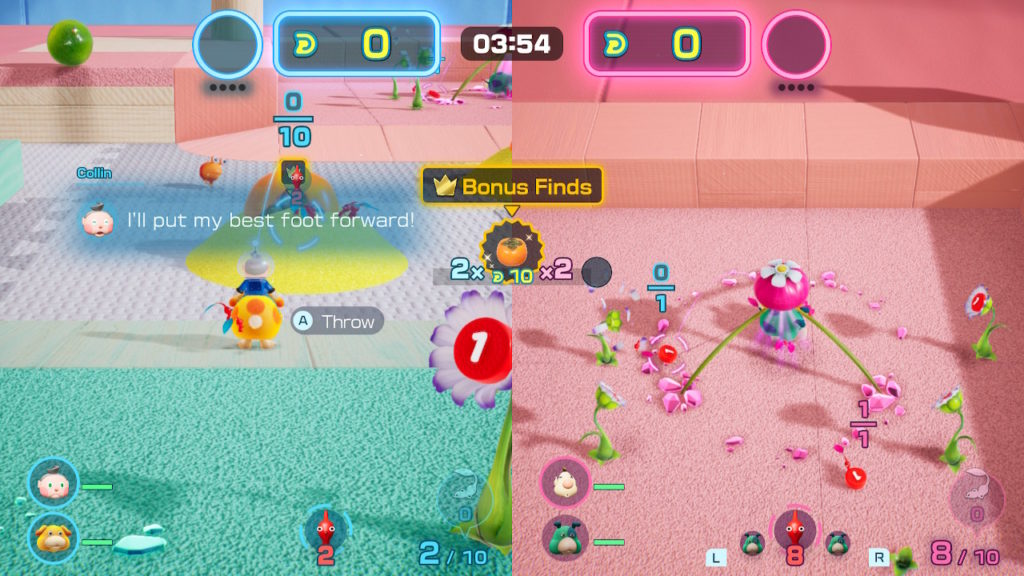
The colourful and chaotic Dandori Battle mode.
There is also the introduction of “Night Time Expedition” and a new type of Pikmin called “Glow Pikmin” which seems to explain what happens when Pikmin are killed and evaporate into little spirits. The night has always represented danger in the series as any Pikmin caught when night falls would be eaten by more aggressive enemies. In these expeditions, the gameplay changes to that of tower defence where the player has to acquire as many Glow Pikmin as possible while defending one or two of their nests from destruction until morning. There is a heavy emphasis on combat in this mode and in the latter stages, there is very little room for error.
These new modes are connected as the as “Leafling” characters found in the Dandori missions need to be healed by acquiring glow sap from the night missions. Something I touched on in my recent review of Sonic Frontiers was that making side-missions or activities a required part of a game’s story mode is poor design. It is a criticism I would also make of the Insomniac developed Marvel’s Spider-Man as well. While the Dandori Challenges/Battles and the Night Time Expeditions are interesting diversions, they should not be mandatory to progress in the game’s Story Mode. I would have much preferred they were limited to side modes completely or only had them included as optional in the main game. These modes are at their best when they add variety to and shake-up the gameplay. Pikmin 4 is quite engaging enough without them. Yet these are a constant presence for most of the game and there are multiple Dandori Battles and Challenges in each area which quickly become tedious. The Night Expeditions are also mandatory up to a point but once you’ve experienced a few, you’ve basically experienced them all.
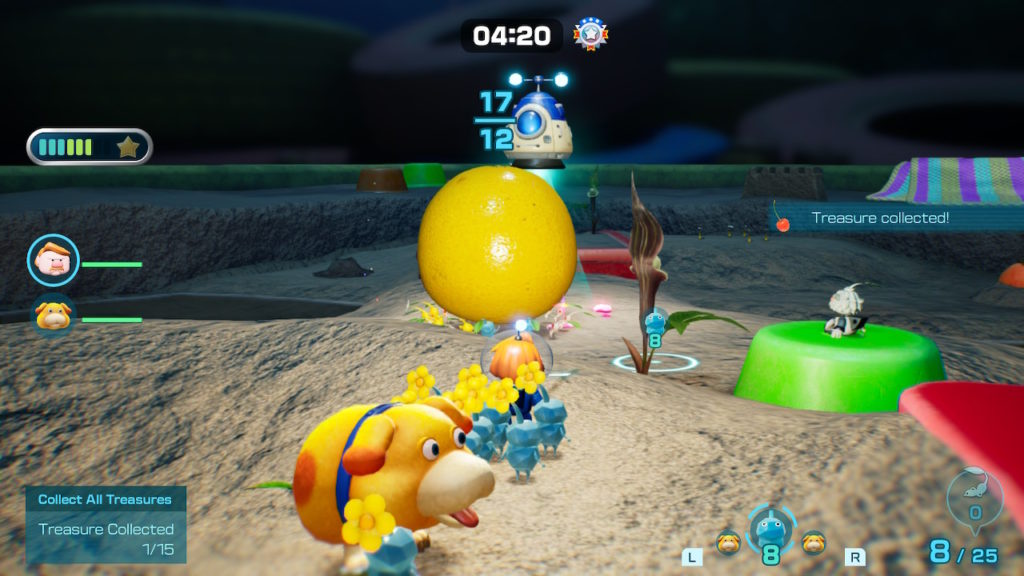
The underground sections are with few exceptions, very dark.
The controls for Pikmin 4 have been simplified from the previous games most notably with an auto-lock feature for targeting objects and enemies. I always preferred the GameCube style so I was not annoyed with this design though it is certainly a consideration for those preferring more precise control schemes found on the Wii and Wii U. The game also includes a rewind option so any time a significant mistake is made, the player is able to rewind time. This was occasionally useful for me as surprise enemies or obstacles can mean disaster when unprepared. The game also automatically saves once a day has begun and there was no way to go back to the hub to prepare or buy items without ending (and therefore wasting), the day. There were a few times during my playthrough where I discovered I simply didn’t have an upgrade or item I needed to progress and so needed to lose a day. In another mode within the story, it has the option to revert days and this would have been welcome in every mode. So on the one hand it can be generous with difficulty but on the other, also puts an irritating barrier up.
Pikmin 4 is full of content much unlike the previous games which mostly benefited from replay and somewhat with the optional side-content. Despite this, I would say that the game overstays its welcome. Padding the length is the aforementioned content that is simply not as fun as the traditional series gameplay. There is also a lot of repeat content especially with enemy encounters. There are new enemies but many very familiar ones return including bosses which become far too familiar. I don’t know how many times I fought variations of the final boss from the original Pikmin and a number of other enemies. There are also side-missions but most of these are completed with normal story progression and so feel redundant. Apart from the variation included with Oatchi, there is also very little that series veterans won’t be familiar with. Environmental puzzles and design are nowhere near as thoughtful as they were in previous entries. There is one very welcome side-story involving Olimar unlocked late in the game that provides more of what the series does best but even this retreads territory already covered only with a little variation.
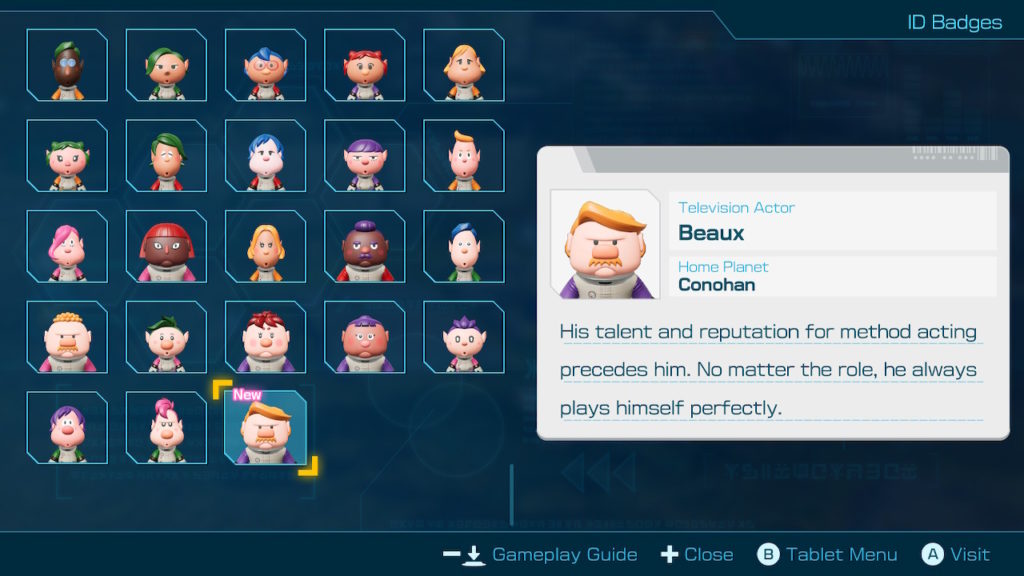
I somehow designed my character exactly the same as Beaux.
One of the biggest missed opportunities is for changing up the games overall setting. As mentioned, early on the player is able to explore an indoor environment which is later returned and there are also some others included in the Dandori modes. However, the other seven major areas of the game are outdoors as in previous games. These are certainly just as beautiful but there was an opportunity to experiment more with Pikmin indoors that went mostly unused. As much of the game also includes the dungeon crawling within caves, many of the environments are also quite dark and bland though there were a few pleasing exceptions to this too.
Although it has received significant acclaim, I would put Pikmin 4 firmly at the bottom in the mainline series. It was by no means a bad game but it does demonstrate the limitations of the series. The game could have been much improved mainly by keeping the side-content optional and making more use of the indoor areas. I certainly quibble with other design choices and the lack of continuity with the previous games but these aren’t bad in and of themselves. I would have been much happier with a shorter story mode that played to the strengths of the series. Then, having the option for a bit of variety at the end would have felt more welcome. I would still consider it worth playing for both new and returning players but Pikmin 4 isn’t the game I was hoping it would be.
